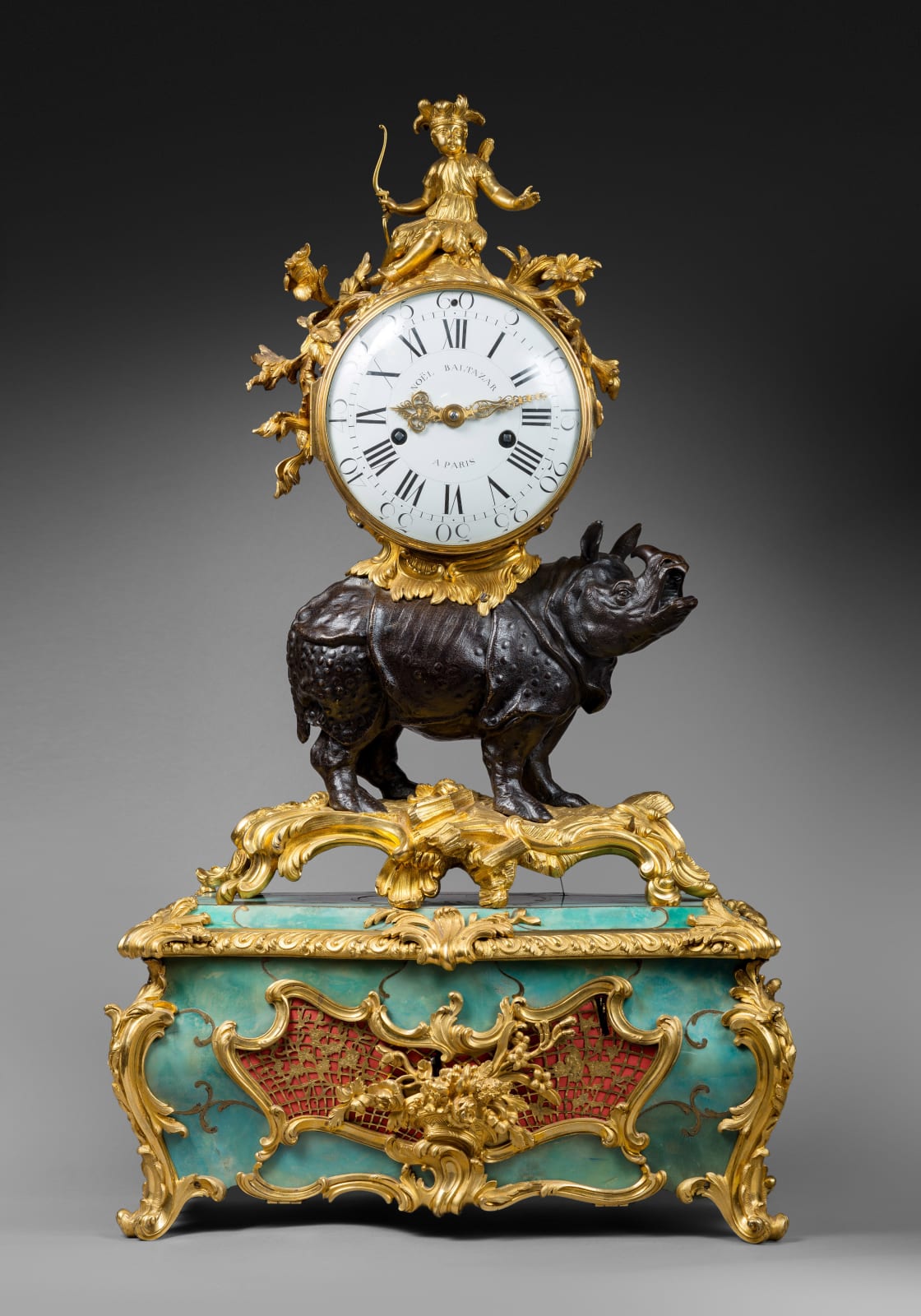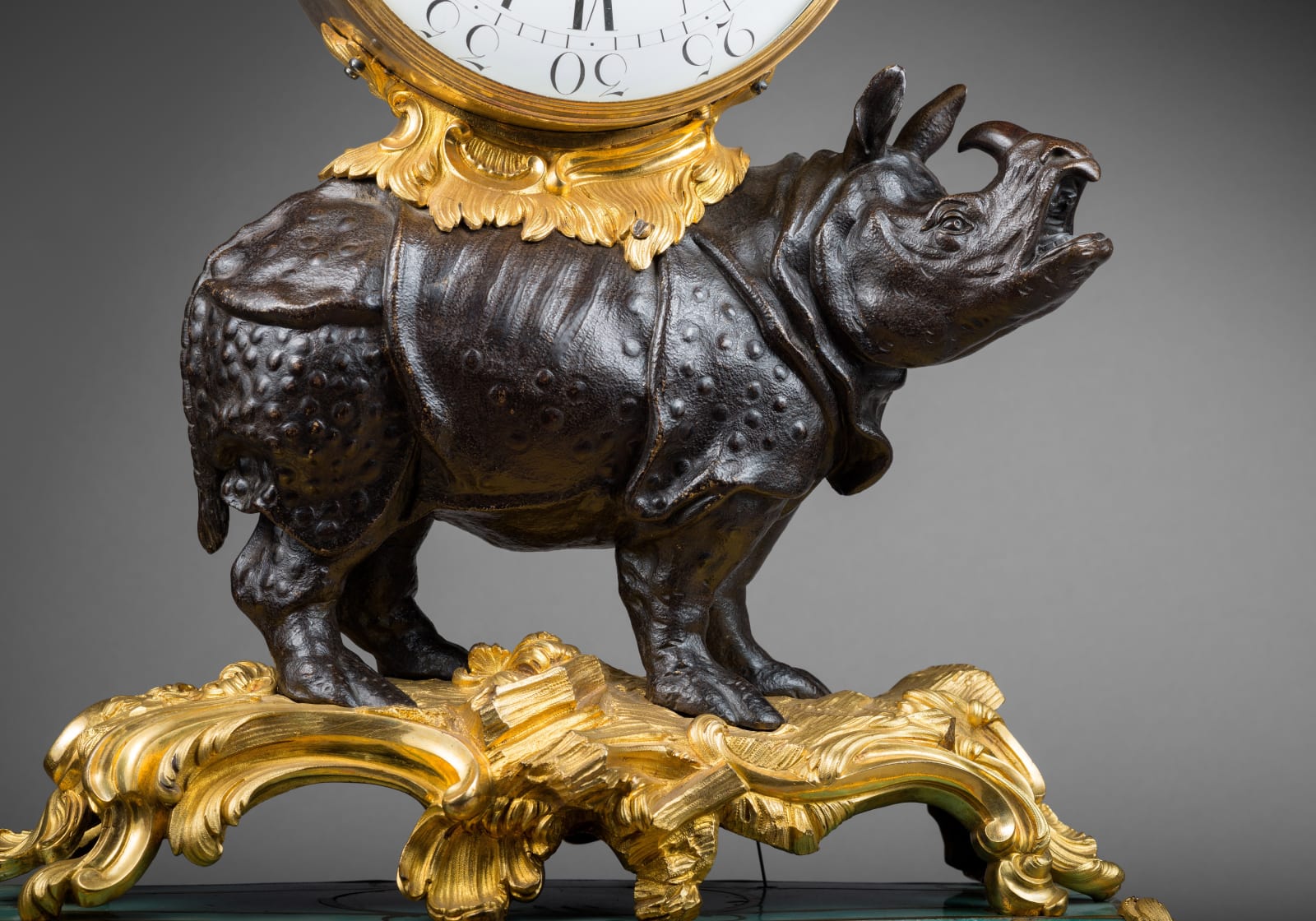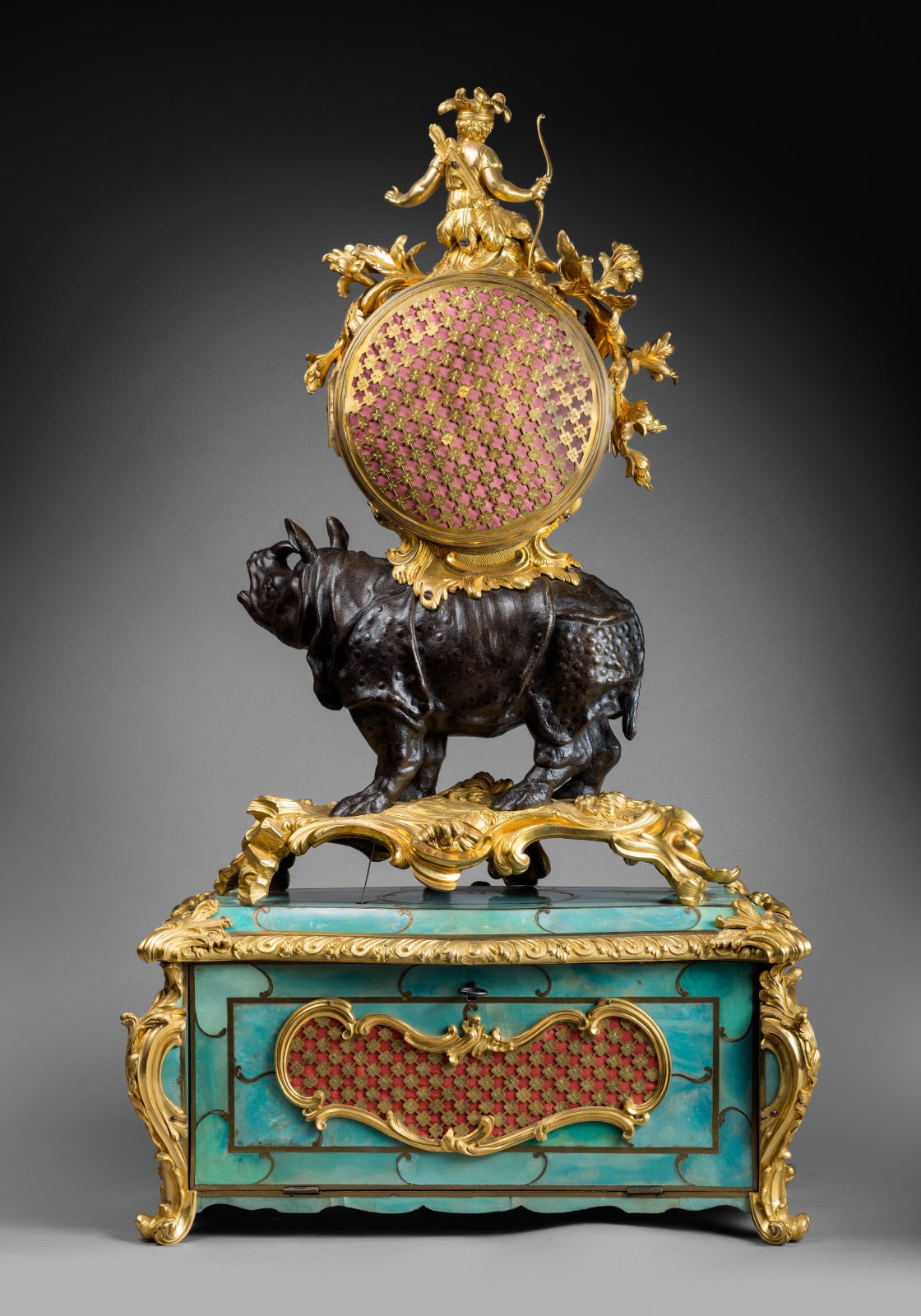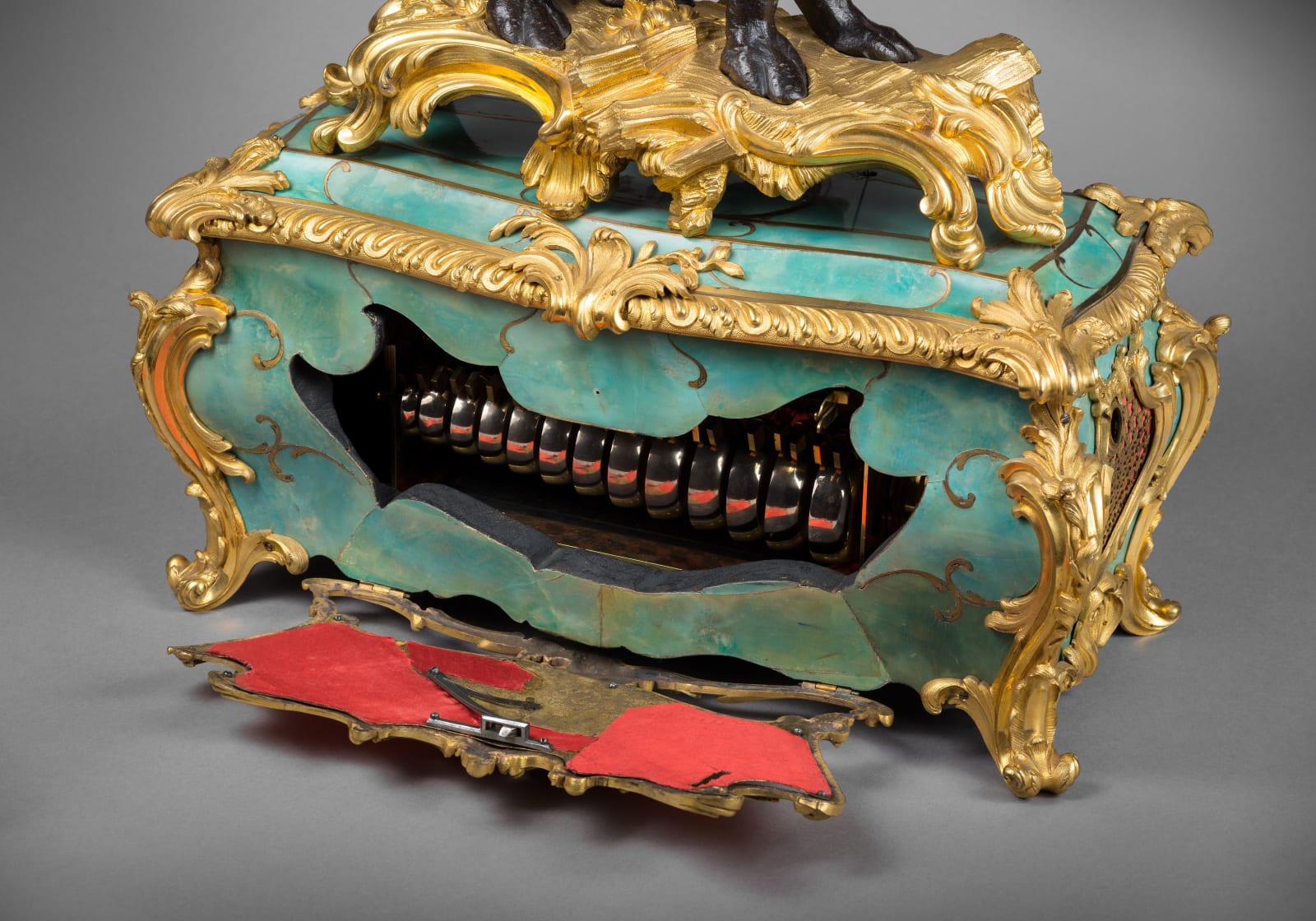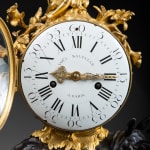Noël Baltazar
Further images
Literature
Hans Ottomeyer and Peter Pröschel, "Vergoldete Bronzen", 1986, p. 122, pl. 2.8.2, illustrating a very similar clock with case by Saint-Germain without musical box but with clock movement by Francois Viger; and p. 119, pl. 2.6.6, illustrating a clock in the Metropolitan Museum, New York with movement by Charles Le Roy housed in a different clock case by Saint-Germain with supporting Chinese figures but surmounted by an identical Indian boy. Jean-Dominique Augarde, "Les Ouvriers du Temps", 1996, p. 156, pl. 123, illustrating an almost identical musical clock with case by Saint-Germain with movement by Gille L'Aine; and p. 56, pl. 37, illustrating a 'Pendule au Dromadaire' also signed Noel Baltazar a Paris on the dial. Pierre Kjellberg, "Encyclopedic de la Pendule Francaise du Moyen Age au XXe Siecle", 1997, p. 129, pl. D, illustrating a very similar clock without the musical box, with case by Saint-Germain and movement by Etienne Le Noir a Paris; and p. 130, pl. A, illustrating a variation of the model without musical box, with the rhinoceros facing in the opposite direction and drum surmounted by a Chinaman, the movement by Jean-Baptiste Baillon. Eighteenth century clock production was an extremely complicated process and involved the collaboration of many different craftsmen belonging to numerous different guilds. This exceptionally fine quality and rare 'Pendule au Rhinoceros' combines the art of three of the most talented craftsmen from that period (as well as many others whose names never appear on the finished piece).
The main characters involved were Jean-Joseph de Saint-Germ who supplied the case, the eminent horologist, Francois Viger (b. circa 1708 d. 1784), who was one of Saint-Germain's main clients. Viger most probably purchased the case direct from Saint- Germain and the carillon from musical as well as the musical movement, which he then supplied to his equally distinguished colleague, Noel Baltazar (also Balthazar; d. 1786). The latter, whose name appears on the dial would have then overseen the finishing process and retailed the final article. One can assume that because Viger signed his name with such flourish and in such an obvious position beside the carillon, that he had a strong hand in the work's overall concept. It was very likely that Baltazar approached Viger stating that he had an important client for a pendule au Rhinoceros' - perhaps similar to one Viger had already put his own name to (see Ottomeyer and Pröschel, p. 122) and that would he, Viger supply him with another from his friend, Saint-Germain, complete with a musical box.
An exceptionally rare and very fine quality Louis XV 'Pendule au Rhinoceros' of eight day duration signed on the white enamel dial Noël Baltazar a Paris and also beautifully inscribed on the plate attached to the musical movement Viger à Paris, housed in a magnificent patinated and gilt bronze case by the eminent bronzier Jean-Joseph de Saint-Germain. The dial with Roman and Arabic numerals and a fine pair of gilt brass hands for the hours and minutes. The movement with silk thread suspension, anchor escapement, striking on the hour and half hour on a single bell, with outside count wheel. The musical movement signed on the mainspring Buzot gbre 1755, with gut fusée and twin spring barrel within rectangular brass plates with square-section steel pillars, the music playing on 23 hammers via 13 bells and a brass pin barrel, playing 13 different tunes, with option to play either a different or the same tune on each hour.
The magnificent drum-shaped case surmounted by a seated Indian boy wearing a plumed headdress with quiver of arrows on his back and holding a bow, supported on the back of a patinated bronze rhinoceros standing on a scrolled base. The bombe-shaped music box enclosing the musical movement, veneered in green horn inlaid with scrolls and scrolled foliate angle mounts, the front with a pierced floral trellis centred by a basket of flowers within a scrolled cartouche-shaped mount and similarly shaped on the reverse
Paris, date circa 1755
Height 92 cm, width 52 cm, depth 24 cm.
The mainspring of the musical movement is clearly signed and dated 1755 and was made by Charles Buzot. Buzot had an important workshop where he specialized in the production of clock springs. His son Jean-Charles Buzot, who served an apprenticeship in 1754 under Ferdinand Berthoud, subsequently joined his father.
Very few clockmakers made carillons for musical clocks, for this again was a very specialized craft, although there were of course exceptions to the rule. For instance Michel Stollenwerck (maitre 1746 d. 1768), who made some of the very finest musical movements of the period, of which this is of the same caliber also made very fine clock movements. It is perhaps no coincidence that he also acquired some of his cases from Saint-Germain. As part of the rococo delight in exoticism, during the early to mid eighteenth century artists continually sought inspiration from the East. Thus a number of clock cases featured unusual beasts that lived naturally in the Middle and Far East. While elephants had been incorporated into clock cases since the Renaissance, clock cases with rhinoceroses or even camels and dromedaries were far less common. Only a limited number of animal clocks were ever made and are thus very rare items and are now among the most prized clocks this period. During the early months of 1749 a rhinoceros, which had been brought to Europe was paraded at Versailles and later taken to Paris. It caused a sensation and soon inspired a vogue for all manner of art incorporating rhinoceroses included the present piece.
Three different types of rhinoceros clock models are know. The earliest, based on a Dürer engraving showed the beast with a second horn on its shoulder. The second, perhaps more realistic version was probably based on a model made by Kändler for the Meissen porcelain factory. The third model, of which this is one, was made at the workshop of the esteemed bronzier, Jean-Joseph de Saint-Germain. Saint-Germain produced several slightly differing versions of this type of clock case. Some were produced as simple clocks while others, like the present piece, had the addition of a musical box. All the corresponding musical boxes were of the same style. In some versions the beast faces in the opposite direction and instead of an Indian boy, a Chinaman surmounts the drum. This version however compares with almost identical versions by Saint-Germain in the Musee du Louvre, Paris and in the collection of the late Florence Gould.
As previously noted, François Viger was one of Saint-Germain's main or most important clients. Viger was a remarkably talented clockmaker. He was born in Dieppe circa 1708 the son of a bourgeois gentleman named Emery and died in Paris on 29th March 1784. After submitting his Ouvrier Libre in 1733, Viger, who was partly trained by Louis Jouard was received as a maitre in 1744 by a decree exempting him from the normal apprenticeship qualifications. From 1770-71 Viger acted as Garde-Visiteur ot his guild and then as Député in 1778.
Although Saint-Germain was his main supplier, Viger also used cases made by the bronziers, Robert and Jean-Baptiste Osmond, the Caffieris, Rene Francois Morlay and Nicolas Bonnet as well as those by the ebenistes, Balthazar Lieutaud and Antoine Foullet. I. P. Gobert and Viole sometimes did the gilding work. The due de Belle-Isle was among his clients, while today his work can be found at the Musee du Louvre and Jacquemart-Andre, Paris; Chateau de Versailles; Foundation Ephrussi de Rothschild, Saint-Jean-Cap-Ferrat and Aschaffenburg Schloss. The Historisches Museum Basel, the Museum of Decorative Arts, Prague and the Hermitage Museum, Saint Petersburg also house examples from his outstanding career. Further works can be found at Liazenski Palace Warsaw; National Museet Stockholm and the Wallace Collection, London. Noël Baltazar, who retailed the finished work and whose name appears on the clock's dial also used cases made by Saint-Germain.
Other cases were supplied by the bronziers, Nicolas Bonnet and Charles Grimpelle and by the ebenistes, Charles Cressent, Balthazar Lieutaud and Jollam. Like Viger, Baltazar employed the gilder, I. P. Gobert as well as Antoine Delaval. Baltazar belonged to a great dynasty of no less than 18 clockmakers spanning four generations. The grandson of Jean-Baptiste and son of Henry Baltazar (d. 1752), his brothers included Charles, Antoine, Denis, Jean-Chrysostome and Joseph-Sylvestre. Two of his sisters married clockmakers and in turn his own son, Etienne-Jacques (1737-73) also worked as a clockmaker. He and his wife, Marie-Geneviève Marlet had another son, Henry-Noël, avocat au Parlement who served an apprenticeship with Antoine Paillard. Received as a maitre in 1717, Noel Baltazar enjoyed a long and prolific career spanning nearly 70 years, having styled himself Horloger de Mesdames since 1769. By 1737 he was established at rue du Roule near the 'Cheval Noir', while 1748 positioned him at the corner of the Place Dauphine and the Quai des Orfevres. J-D Augarde notes that from 1769-86 he had a permanent stock of interesting pieces worth about 8000 livres. The Waddesdon Collection, Buckinghamshire owns a splendid clock by him, while other examples of his work can be found at the Musee du Louvre, Paris; Musee National, Poznan; Frederiksborg Castle and the Museo d'Arte Industriale, Milan.
